Once the operational objectives have been agreed on, it will be necessary to determine the required management measures. These should, as far as possible, build on and strengthen existing measures, adapting them as necessary in order to keep the costs and any negative social impacts of the changes as low as possible while still achieving the agreed objectives. Nevertheless, adaptations or extensions to existing measures will almost always be required for the implementation of EAF.
With EAF, the range of input and output controls and the type of measures used to regulate fishing mortality need to be considered in a far broader context. The measures should not only address a series of target species concerns, but should also be aimed at maintaining or restoring the structure and functioning of the ecosystem. Managers should take the functioning of the ecosystem into account when drawing up their approach. They need to be aware of the potential problems related to measures such as restocking and culling. Habitats may also need to be adapted to enhance the populations of target species or to restore degraded areas.
| Important note: | |
| Many of the problems facing fisheries management fall outside the direct control of fisheries managers. Examples of such problems include: | |
| - | the degradation of coastal waters as a result of agricultural or industrial runoff; |
| - | introduction of exotic species through ballast water and the hulls of container ships; |
| - | destruction of fish habitats through foreshore development, offshore mining, oil and gas exploration and extraction and other human activities; |
| - | the contamination of fishery products by agriculture and industry; |
| - | coastal erosion and the degrading of coastal habitat; |
| - | the use of freshwater for power stations, irrigation and human settlements which changes river flow; |
| - | climate change which affects the distribution and productivity of stocks; |
| Fisheries managers need to ensure that they are recognized as important stakeholders in the broader process of integrated coastal management. | |
WHAT ARE THE KEY EAF MANAGEMENT OPTIONS?
The following section describes how current management processes would change under EAF. One of the most important consequences of EAF is that it will often require the involvement of more stakeholder groups. This will increase the time and costs required for effective consultation and could also make agreement and compromise more difficult to reach. Where stocks are shared by more than one country, the management measures should be coordinated between the different countries sharing the resource.
Technical measures
Fishing gear regulations
Almost all fishing gear impacts on marine life, sometimes in unexpected ways. Usually, fishing methods are developed to catch only a target species or group of species in a particular habitat but they may also catch non-target organisms (bycatch) or be used in the wrong habitat and cause environmental damage. Fishing may also remove only the larger fish from a population which changes the size composition of the species. The consequences of impacts such as these for the ecosystem may be severe and need to be considered under EAF. Some of the gear- and size-selectivity options are as follows.
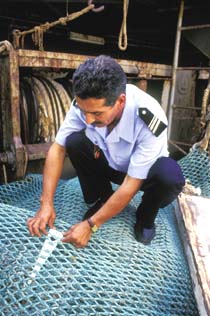
G. BIZZARRI, FAO/21972
An inspector at Agadir port, Morocco using a gauge to measure stretch mesh in the codend of a trawlnet.

ÅSMUND BJORDAHL, INSTITUTE OF MARINE RESEARCH
Shrimp trawl with sorting grid (expanded view). Shrimp and fish that pass backwards in the trawl are guided by a funnel to the bottom of the backwards slanting metal grid. Shrimp and fish of comparable size will pass through the slots of the grid and go to the codend, while larger fish and other organisms (e.g. jellyfish) will slide upwards over the grid and are released through the outlet.
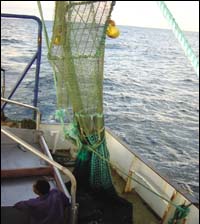 | Bycatch reduction devices in action. Two devices (an aluminum grid for releasing large animals such as turtles and sharks, and a square-mesh escape panel for releasing small fish) installed in a commercial prawn trawl in Mozambique. |
| SEAN FENNESSY, OCEANOGRAPHIC RESEARCH INSTITUTE | |
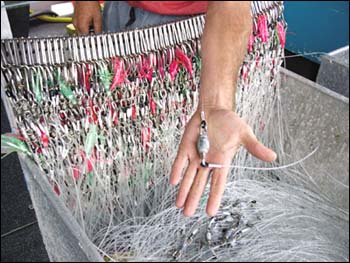
SAMANTHA PETERSEN, BIRDLIFE SOUTH AFRICA
Weighted branchlines on tuna fishing gear, designed to increase the sinking rate of the baited lines and so reduce mortality of seabirds.
Spatial and temporal controls
The impact of fishing on target and bycatch species can be modified by restricting fishing activity to certain times or seasons, or by restricting fishing in particular areas. Such measures may help to reduce the mortality rate of individuals of either target or non-target species in vulnerable life stages. Closures may be used to protect critical habitats where fishing activity would otherwise cause damage to the physical structures supporting the ecosystem.
Marine protected areas (MPAs) have been widely used to protect biodiversity and specific habitats, with mixed results. MPAs range from zones in which no fishing is allowed (reserves) to areas in which fishing is strictly controlled. Effective MPAs are known to benefit the conservation of some species and the maintenance of biodiversity. If they are properly designed and enforced they may also be useful to fisheries. However, badly designed MPAs or MPAs that are not properly monitored and controlled will have little or no benefits and may even have negative impacts on fisheries.
Effective MPAs can protect sedentary species and allow a proportion of the stock to remain free of the genetic selective effects of fishing. They may allow for the accumulation of spawning biomass so that surrounding areas may be replenished, either through the migration of fish or the dispersal of juveniles.
Area closures that allow some fishing may require a large enforcement effort and can be costly. Allowing certain categories of fishing activity can also create loopholes which undermine the intentions of the closure. Management authorities need to consider the cost of enforcing closed areas, bearing in mind that vessel monitoring systems (VMS) may make it easier to enforce area-based management in some regions of the world.
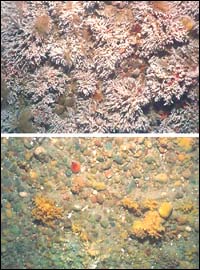
DANN BLACKWOOD AND COURTESY PAGE VALENTINE, US GEOLOGICAL SURVEY
Photographs of bottom habitat on the Georges Bank in the Atlantic coast of northern United States before (top) and after (bottom) being fished with a dredge to catch scallops. Closed areas and MPAs are frequently important to protect critical habitats from such damage. A system of seasonal and year-round closures is used in north east United States also to contribute to management of 20 groundfish stocks. It includes an area of more than 22 000 km2closed year-round to any fishing gear capable of catching groundfish. The closed areas led to big increases in abundance of some commercial and non-commercial stocks, although not for all, with the more sedentary species benefiting the most. There was also spillover offish from the MPAs into the fishing grounds for some commercial species (including scallops, haddock and some flounders) but not all. This example demonstrates the potential value of MPAs but also the need to be clear on the objectives for their use. The benefits will depend, amongst other factors, on the species being protected, the placement and size of the reserves and the integration of MPAs with other management measures. More information can be found at www.whoi.edu/oceanus/viewArticle. oid=3782&archives=true&sortBy=printed
Energy efficiency and pollution
Many modern fishing vessels use fossil fuels for propulsion, to operate the fishing gear and to preserve and process the catch. Technological innovations to reduce the emission of CO2and other gases are encouraged. Increasing the efficiency of fishing gear and improving management approaches all result in a reduction in the fishing effort required.
Input (effort) and output (catch) control measures
Controlling overall fishing mortality
Management methods that are used to control fishing mortality are often referred to as input and output controls. Input controls can be used to regulate fishing capacity (the total effort achieved if the entire fleet were to fish full time), and to control fishing effort (the actual fishing pressure that is exerted). Output controls are intended to regulate the catch of a species or group of species directly.
Capacity limitation seeks to limit the total size of the fishing fleet.This has the advantage of reducing the pressure that frequently arises from an overgrown industry to allow higher fishing effort than would otherwise be permitted. Appropriate capacity controls can lead to reductions in fishing mortality on the target species, as well as a wide range of associated species.
Effort limitation seeks to restrict the fishing activity of fleets and thereby limit or reduce fishing mortality. This will usually be an effective measure in multispecies fisheries as the reduction in fishing effort will lead to reductions in fishing mortality for all species caught. There is a danger that effort and capacity excluded from one fishery or area may simply be transferred to other ecosystems and resources that are already fully fished. Where effort reduction is being implemented, steps must be taken to prevent this happening. Controlling effort in a context of excessive capacity (e.g. fleet size) is often difficult.
From an EAF viewpoint, input controls are beneficial because they restrict the overall pressure on the ecosystem. Without effective monitoring and control, however, there is always the possibility that fishing mortality will continue to increase steadily. Another problem with input controls is that new technologies and experience tend to lead to gradual increases in fishing efficiency. This leads to an increase in the actual fishing effort and a consequent increase in fishing mortality. Suitable monitoring and controls need to be implemented to compensate for increases in efficiency. However, some technological advances, such as the use of echo sounders, may enable fishermen to direct more of their effort towards the target species and decrease the impact of fishing on non-target species.
Catch controls are aimed at directly reducing fishing mortality on target species. If complemented with bycatch controls (such as bycatch quotas) they have the potential to protect associated species. However, catch controls can lead to undesirable outcomes such as discarding of lower value species or smaller size classes. When implementing EAF in a mixed-species fishery, consideration needs to be given to the different characteristics of the various species when catch controls are set. Otherwise, more vulnerable and less productive species may be overexploited as vessels attempt to fill their quotas of the more valuable and productive species. Catch limits for target species may therefore need to be modified to control catches of more vulnerable species. The catch limits should also address the ecosystem related objectives, such as maintaining food webs.
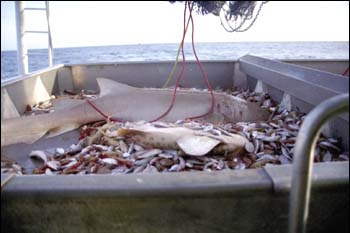
GARRY DAY, AUSTRALIAN MARITIME COLLEGE
A mixed-catch from the Northern Prawn Fishery in Australia. The fishery targets nine species of prawn (shrimp) and takes a substantial and very diverse bycatch of teleost fish, elasmobranchs, turtles, sea snakes and many invertebrate species. These include some endangered and protected species, The fishery is controlled primarily by regulating fishing effort, leading to significant reductions in impacts on bycatch species. There are also a number of other important management measures intended to reduce bycatch directly, in particular the compulsory use of TEDs and BRDs and, recognizing the importance of coastal habitat to fishery production, seagrass beds and inshore waters are closed to trawling.
Ecosystem manipulation
In some situations, technology and understanding of marine ecosystems have advanced to the point where ecosystems may be manipulated to achieve the desired use, conservation and restoration objectives. Ecosystem manipulation may help to mitigate overfishing or habitat destruction. Mitigation is rarely completely effective and it is usually very expensive.
Habitat modifications
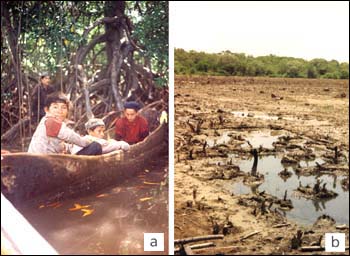
INTERNATIONAL COLLECTIVE IN SUPPORT OF FISHWORKERS (ICSF)
Preventing loss of or damage to critical habitats is an essential component of an ecosystem approach to fisheries. Figure 7a) Fishing for shellfish and crab in a mangrove area in Brazil. Figure 7b) Cleared mangroves for shrimp farming and salt production in Brazil, showing the loss of mangrove habitat. Mangroves provide habitat for many species and important nursery areas for a number of commercially important fish species.
Artificial habitats (if well located and designed) have the potential to improve production by increasing the settlement success of juveniles in years of abundant seed supply. Artificial habitats may also play an integral part in a restocking or stock enhancement programme by permitting a larger number of animals to be released.
Population manipulation
Restocking and stock enhancement
Target species that
have been heavily overexploited may be restored by releasing cultured
juveniles to rebuild the spawning
biomass. As there are often high costs involved in restocking programmes, careful analysis is needed to
determine whether the goals of rebuilding stocks can be achieved by other management measures. Restocking
should only be considered when other forms of management are incapable of restoring populations to
acceptable levels. It should be coupled with effective control of fishing capacity.
Stock enhancement is an activity or programme designed to increase the size or growth of the fishery resource stock. It may include restocking programmes but can also involve activities such as habitat engineering and introducing new species or new strains of existing species. As with restocking programmes, careless hatchery practices could also result in the release of individuals unfit for survival in the wild, modification of genetic diversity and the introduction of diseases.
Culling
Culling is aimed at reducing the abundance of
predators
or species that compete for the same trophic resources, in order to increase the
yields of
target species or to maintain the balance of the trophic structure. Such food-web
manipulation needs to be carried out with caution to ensure that it produces only the
desired effect and does not result in unwanted changes in abundance of other important components
of the ecosystem, or threaten the survival of the species culled.
Intentional introductions
Although new fisheries can be created
by introducing species, there is a high risk of causing detrimental changes in coastal
ecosystems. A precautionary approach is needed here, but this does not mean that the measure
should never be considered. Some introductions of marine species have resulted
in social
and economic benefits with no apparent impacts on other components of the ecosystem.
A comprehensive
risk assessment should be undertaken before considering the creation of new fisheries based on introduced species so as to understand the
benefits and consequences of such
measures.
RIGHTS-BASED MANAGEMENT APPROACHES
An appropriate system of allocating access rights in a fishery should ensure that fishing capacity and effort correspond to the productivity of the resource. It should also ensure longer-term security for the rights holders and enable them to view the resource as an asset to be used responsibly.
Territorial use rights (TURFs) are rights granted to individuals, groups or communities to fish in certain, clearly defined locations. TURFs are frequently used in combination with decentralization of control, giving the rights holder in a particular TURF control over some or all management functions, for example surveillance and compliance.
Limited-entry systems allow only a certain number of individuals or vessels to take part in a fishery, with entry being granted by way of a license or other form of permit. Entry may also be regulated through a system of effort rights (input rights) or by setting catch controls (output rights), where the total allowable catch (TAC) is split into quotas and the quotas allocated to authorized users.
Each type of right has its own properties, advantages and disadvantages. Further, the ecological, social, economic and political environment varies from fishery to fishery. As a result, no single system of use rights will work under all circumstances. It is necessary to devise the system that best suits the fishery. An access rights system may well include two or more types of use rights within a single fishery or geographic area.
By way of example:
EAF requires that all the uses and users of a fishery resource be considered and their objectives reconciled, and that interactions between different fisheries within a geographic area be taken into account. Therefore, the systems of access rights across different fisheries within a management area need to be compatible. The total effort applied also needs to correspond with the productivity of the ecosystem and its component parts. While difficult to implement, this will be essential for the sustainable use of ecosystems.
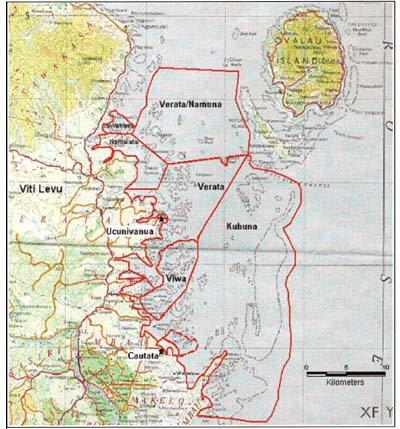
JIM ANDERSON MRAG LTD
TURFs, known locally as community fishing rights areas (CRFAs) or “Qoliqoli”are used in Fiji. The red lines show the CRFA boundaries as defined by the Native Lands Trust Board (NLTB) of Fiji. The area of the largest CRFA is 362 km2 encompassing 86 km2 of coral reef habitat while the smallest, occurring inshore and including mangrove habitat is only 3 km2. The boundaries of the CRFAs were determined largely by cultural politics. The larger CRFAs are probably of a suitable size for management, given the likely movement patterns of finfish, while the smaller ones are almost certainly too small and fish “stocks” are likely to cover more than one CRFA.